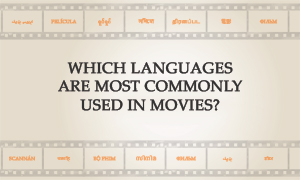 Tui got in touch to ask “I was wondering how many Non-U.S. English-language narrative drama features get Theatrical North American distribution“. It’s a great question and so I set about answering it. In the end, the data took me on quite a journey, so I’m splitting what I found into two articles:
Tui got in touch to ask “I was wondering how many Non-U.S. English-language narrative drama features get Theatrical North American distribution“. It’s a great question and so I set about answering it. In the end, the data took me on quite a journey, so I’m splitting what I found into two articles:
- This week – What languages are most commonly used in movies?
- Next week – How many non-English language films get a US theatrical release?
This research looks at all movies released in North American cinemas for the fifteen years between 2003 and 2017 (inclusive), including re-releases and re-issues of older movies.
How many languages are in modern movies?
Films can have more than one language, and indeed, 31% of the films in my study did. The film with the highest number of languages is Life in a Day, featuring at least twenty. 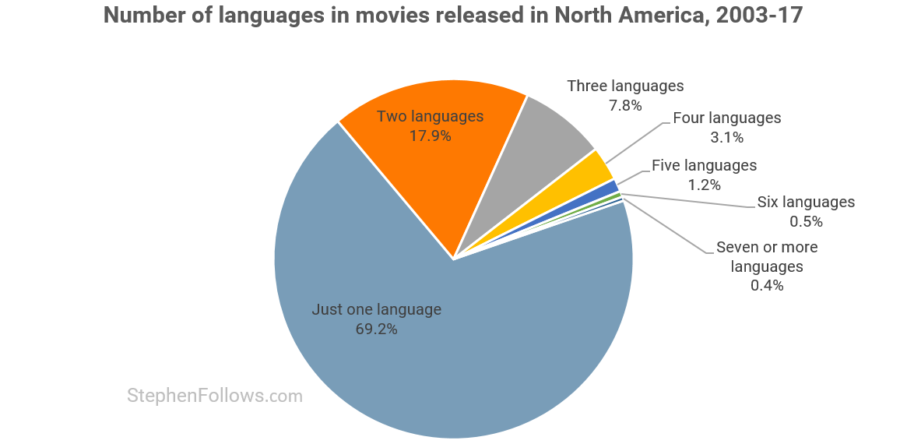 Across all my movies I counted 168 unique languages, although only fifteen featured in more than 100 movies. Not all are current; Latin is the 16th most frequently used non-English language spoken in movies (2003-17). It may be officially classed as a ‘dead language’ but it’s alive and well on the big screen.
Across all my movies I counted 168 unique languages, although only fifteen featured in more than 100 movies. Not all are current; Latin is the 16th most frequently used non-English language spoken in movies (2003-17). It may be officially classed as a ‘dead language’ but it’s alive and well on the big screen.
Also represented were fictional languages such as Klingon (from the Star Trek universe), Na’vi (from Avatar) and languages from The Lord of The Rings / Hobbit universe, including Quenya and Sindarin.
The most popular languages in modern movies
Across those 8,798 movies studied, 81.4% featured English as one of their main languages.
Other popular languages included French (featured in 12% of movies), Spanish (8.6%), German, (5.2%) and Hindi (4.9%). 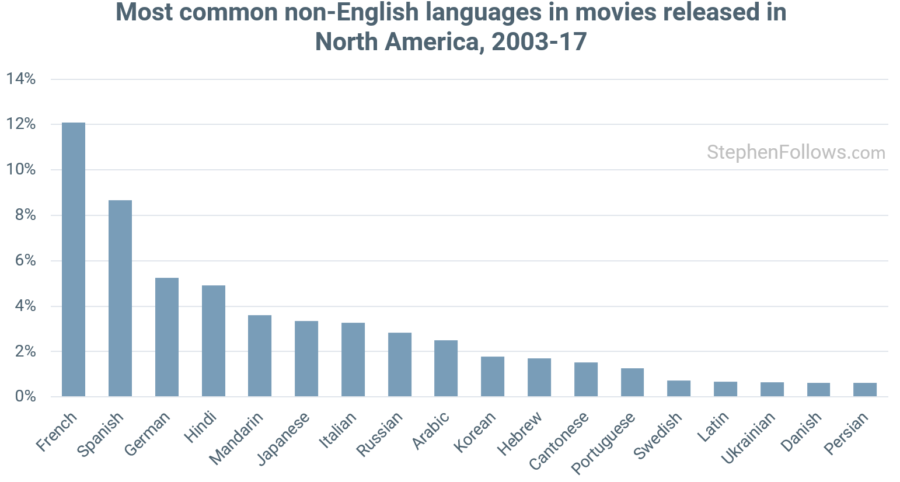 If these numbers seem high, remember that a movie will show up on the list even if just a few lines are in that language. It’s not that 12% of movies are entirely in French, but rather than 12% of movies feature at least one line in French at some point.
If these numbers seem high, remember that a movie will show up on the list even if just a few lines are in that language. It’s not that 12% of movies are entirely in French, but rather than 12% of movies feature at least one line in French at some point.
Which languages are rising and which are waning?
European languages fared well on the previous chart, taking the three top spots. This may not last if current trends continue, as many of the top European languages are in decline, with French hardest hit. In 2003, 16% of movies featured at least some spoken French, whereas in 2017 it had fallen to just 6%. 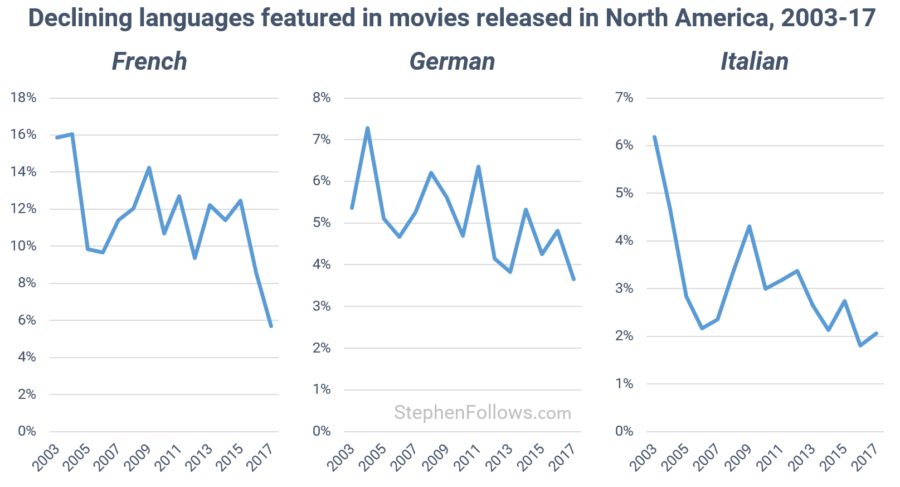 On the flip side, a number of Asian languages are increasingly appearing in movies, with Mandarin, Korean and Hindi all growing in usage.
On the flip side, a number of Asian languages are increasingly appearing in movies, with Mandarin, Korean and Hindi all growing in usage. 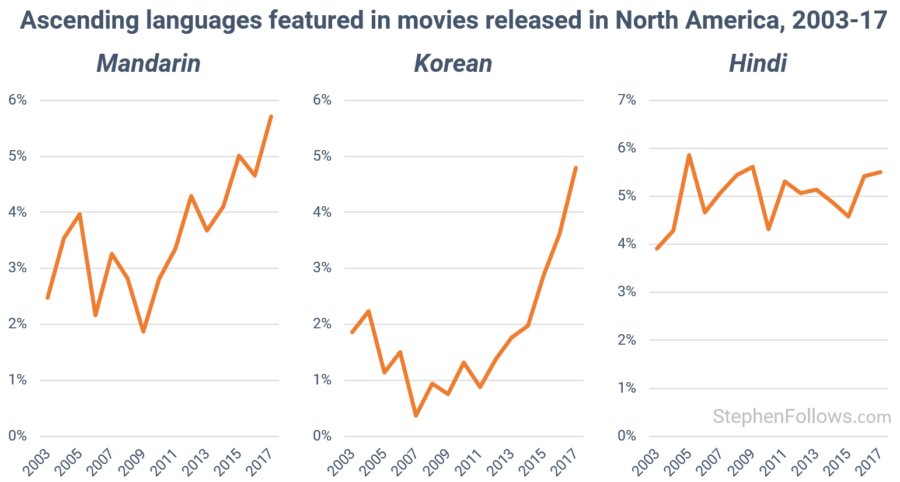
How genres change between languages
As a final part of today’s instalment on languages, let’s look at how languages differ between genres.
The charts below show what percentage of movies in each language are of a certain genre. For example, in my study, I found 1,064 movies featuring French, of which 283 were comedies. In this case, French would show up as 27% on the comedy chart, as that’s the percentage of French-featuring films which were comedies. It can take a moment to get your head around, but once you do it’s fascinating to see how genre and language are correlated.
Of the most commonly-used languages, Hindi has the highest proportion of comedies, accounting for 43% of all films featuring Hindi. Films featuring Russian and Arabic are least likely to be comedies. 23% of all films featuring Japanese in US cinemas are animations. 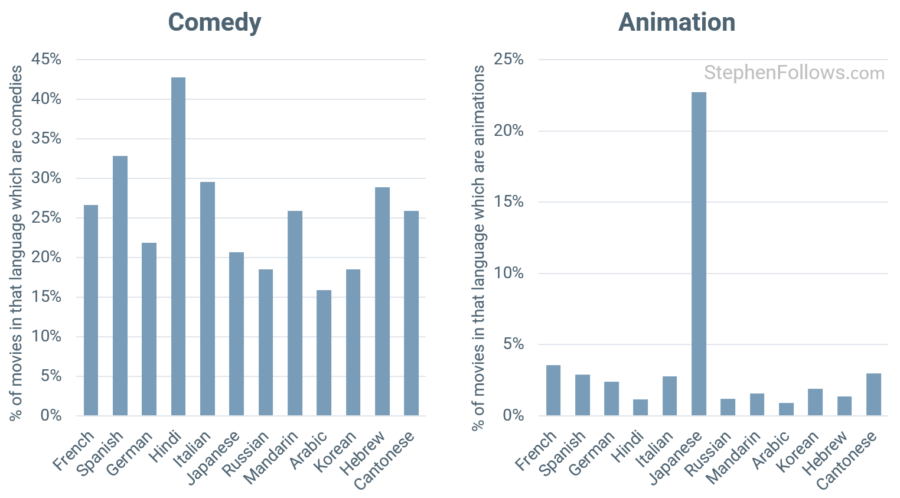 Horror is also a popular genre of films featuring Japanese. That said, it lags behind Latin, which I’ve added to the chart below, despite Latin not being in the main line-up of ‘most commonly used languages’. Perhaps surprisingly, Romance is more a feature of films with Italian than those with French.
Horror is also a popular genre of films featuring Japanese. That said, it lags behind Latin, which I’ve added to the chart below, despite Latin not being in the main line-up of ‘most commonly used languages’. Perhaps surprisingly, Romance is more a feature of films with Italian than those with French. 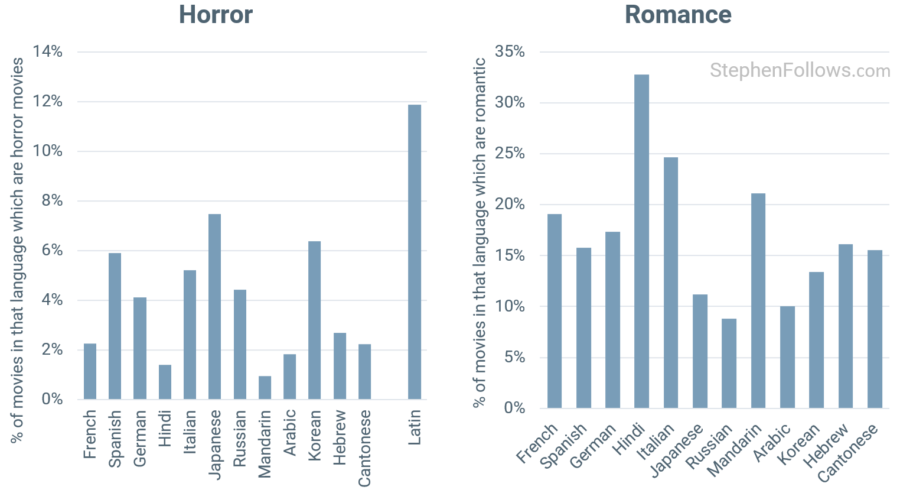 Finally, let’s turn to sci-fi and war movies. Over one in ten films with Russian dialogue are science fiction movies. War movies make up a disproportionately large share of the movies featuring dialogue in German, Arabic and Hebrew.
Finally, let’s turn to sci-fi and war movies. Over one in ten films with Russian dialogue are science fiction movies. War movies make up a disproportionately large share of the movies featuring dialogue in German, Arabic and Hebrew. 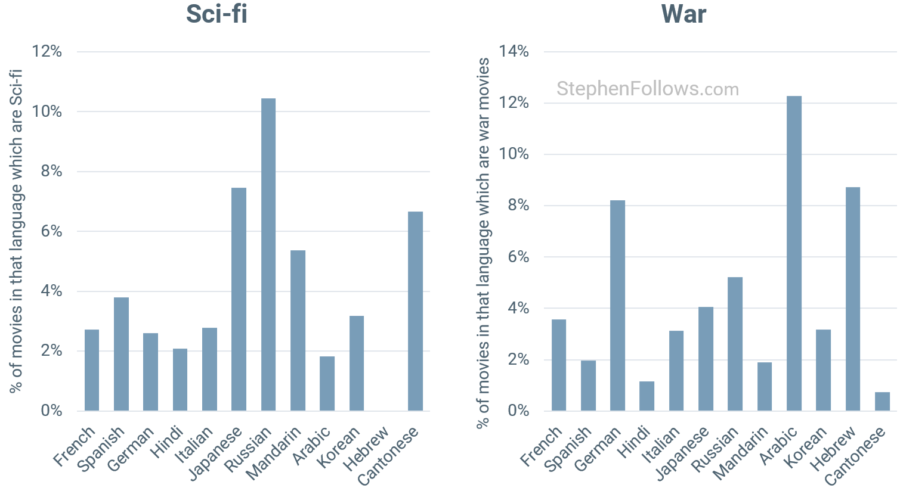
Notes
Today’s data came from IMDb, Box Office Mojo, The Numbers and Wikipedia. The study looks at feature films shown in US cinemas between 1st January 2003 and 21st December 2017 and includes re-releases and re-issues. I did not watch every movie, noting all languages spoken, and so I am slightly at the mercy of public information. I did cross reference data between sources, and in a few cases, dig deeper individually. This may mean that some movies are missing the fact that a single character spoke a line in a non-English language. However, I do not feel this would skew the overall results.
Unless otherwise stated, all figures relate to the North American (i.e. “Domestic”) box office gross. I have not accounted for inflation in these figures.
Theatrical tracking of very small releases can be patchy. This means that if a film opened on a couple of screens for just a week, then it could be missed by the organisations that gather data. Therefore, the raw numbers of movies may be slightly higher, although these kinds of errors are unlikely to affect the box office totals as once a movie starts to gross well, it will quickly get noticed.
I wanted to go back further than fifteen years but the further back you go the patchier the data becomes, and as non-English language films are more likely to be the smaller films (and thus most overlooked) the topic is disproportionately affected by poor data. 2003 was the oldest year for which I could be confident I had tracked at least 99% of movies released.
Many official listings of movies just put “Chinese”, rather than Mandarin or Cantonese. When researching the movies to discover which was used, I found that often the quickest route was to look for people complaining about the pronunciation (such as here for Wonder Woman). Sometimes, it wasn’t clear which Chinese language was used and so I made an assumption based on the actors and the language they most commonly spoke on-screen in other movies.
In the section looking at genre, it’s important to remember that this refers to the films which make their way to US cinema screens. It’s not a comment on the national film output of countries which speak each language. If you want to get an idea of which genre is favoured in each country’s film production, you may enjoy an article from the start of the year entitled How the genre of film production changes around the world.
Epilogue
Today was another example of a great question from a reader (thanks Tui!). If you have a question or query, then drop me a line.
If you’re running a film-based pub quiz and need a tough tie-break question, try this one:
Of all the languages spoken in all of the movies released in US cinemas (2003-17), which language has both the highest average budget and the highest average gross?
Answer in 5.. .
4
.
3
.
2
.
1
.
Answer: Greenlandic. It is an Inuit language spoken as one of the two languages in Gravity, meaning that the average budget for Greenlandic language movies is $100 million and the average domestic gross is $274 million.

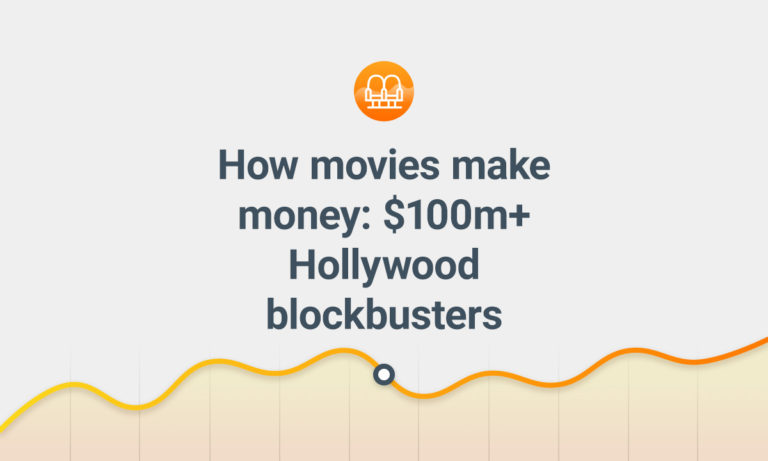



Comments
Hi,
This is interesting. I have a specific query. I come from South India and India is home to not just Bollywood which is Hindi cinema but also several other film industries based on regional languages. I’m not sure but I believe that movies from these other Indian also release in the US in almost the same number as Hindi films do. So, I’m a bit surprised that they didn’t show up. Maybe all Indian movies are tagged Hindi? Is that a possibility?
Or is it that the regional movies release in lesser number than Hindi? A
Hello Stephen,
I’m just curious. As a German, we translate and voice over a lot of foreign movies mostly English spoken movies. So far I could not find the film or movie with the most language tracks.
Can you please check and help to find that out?
How far off the chart did African languages show up… ?